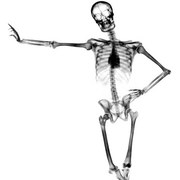 Photo: Getty Images
Photo: Getty Images
Reports of studies on bone health have often spoken about how the loss in "quantity and mass" of the bones in an elderly population is the primary cause for frequent fractures and general bone health deterioration.
However, studies conducted by scientists at the Lawrence Berkeley National Laboratory (U.S Department of Energy) now add to that line of thought. Apparently, the loss of bone health also occurs due to a qualitative change for the worse inside the bones of the elderly.
This looks at bone health of the aging population from an intrinsic perspective. The study was supported by a grant from the National Institutes of Health. (1)
With the help of techniques such as X-rays, macroscopic fracture testing tools and electron-based analytical devices, the researchers examined the cortical bones of the senior population and were able to view and assess the qualitative degradation of the mechanical properties of their bones.
The reason cortical bones were studied is because they form the solid mass of bone and account for almost 80 percent of the body’s total skeletal weight and are responsible for body movement and protection of our internal organs. (2)
The cortical bones also give us primary shape, toughness and strength apart from stiffness, all of which are possible because of the nanoscale structure of the cortical bones.
The study looked at multiple length scale as well as hierarchical structure of these bones. The lengths of scale that were studied in the research ranged from the molecular level up to the osteonal structures at millimetre levels.
According to Berkeley Lab materials scientist Robert Ritchie, “Based on multi-scale structural and mechanical tests, we attribute this degradation to a hierarchical series of coupled mechanisms that start at the molecular level.” (3)
To assess if the bone health of a person is taking a turn for the good, observations of cortical bones at small length scales need to be made. A positive development would signal a better intrinsic strengthening mechanism. The extrinsic toughness mechanisms would be occurring at longer scales inhibiting the growth of cracks.
As a person grows old, there occurs a significant increase in the non-enzymatic cross-linking between collagen molecules which eventually brings down the plasticity of the bones at the nanoscale level. This means that the collagen fibrils are not able to readily slide over one another in case of an impact in order to absorb shock.
As per Ritchie, “We also found that biological aging increases osteonal density, which limits the potency of crack-bridging mechanisms at micrometer scales.” (3)
SOURCES:
1. The Brittleness of Aging Bones – More than a Loss of Bone Mass; Berkeley Lab - News Center; Lynn Yarris; August, 2011;
http://newscenter.lbl.gov/news-releases/2011/08/29/the-brittleness-of-aging-bones-%E2%80%93-more-than-a-loss-of-bone-mass
2. Musculoskeletal System: Anatomy, Physiology, And Metabolic Disorders; Summit, New Jersey: Ciba-Geigy Corporation; Netter, Frank H; 1987; ISBN 0-914168-88-66
3. The Brittleness of Aging Bones: More Than Loss of Bone Mass; Science Daily- Science News; August 2011; http://www.sciencedaily.com/releases/2011/08/110829114727.htm
Technical report of the study may be accessed at:
1. Age-related changes in the plasticity and toughness of human cortical bone at multiple length scales; Cellectis; Elizabeth A. Zimmermann, Eric Schaible, Hrishikesh Bale, Holly D. Bartha, Simon Y. Tang, Peter Reichert, Bjoern Busse, Tamara Alliston, Joel W. Ager III, and Robert O. Ritchiea; August, 2011; http://www.pnas.org/content/108/35/14416
INFORMATION IN THIS ARTICLE IS NOT MEDICAL ADVICE. ALL INFORMATION GIVEN IS TO BE CHECKED WITH YOUR DOCTOR BEFORE IMPLEMENTING OR TAKING THEM AS STANDARD OR VERIFIED.
Mamta Singh is a published author of the books Migraines for the Informed Woman – Tips From A Sufferer: ISBN: 978-81-291-1517-1 (Publisher: Rupa & Co. URL: http://www.amazon.com/Migraines-Informed-Woman-Tips-Sufferer/dp/8129115174/ref=sr_1_2?ie=UTF8&s=books&qid=1298990756&sr=1-2), Mentor Your Mind – Tested Mantras For The Busy Woman: ISBN: 978-81-207-5973-2 (Publisher: Sterling Publishers; URL: http://www.amazon.com/Mentor-Your-Mind-Tested-Mantras/dp/8120759737/ref=sr_1_1?ie=UTF8&qid=1316063179&sr=8-1) and the upcoming Women’s Complete Fitness Guide (Publisher: Hay House India).
She is also a seasoned business, creative and academic writer. She is a certified fitness instructor, personal trainer and sports nutritionist through IFA, Florida USA. Mamta is an NCFE-certified Holistic Health Therapist SAC Dip U.K. She is the lead writer and holds Expert Author status in many well-received health, fitness and nutrition sites.
She runs her own popular blogs on migraines in women and holistic health. Mamta holds a double Master's Degree in Commerce and Business. She is a registered practitioner with the UN recognised Art of Living Foundation. Please visit www.mamtasingh.com
Reviewed February 23, 2012
by Michele Blacksberg RN
Edited by Jody Smith






Add a CommentComments
There are no comments yet. Be the first one and get the conversation started!